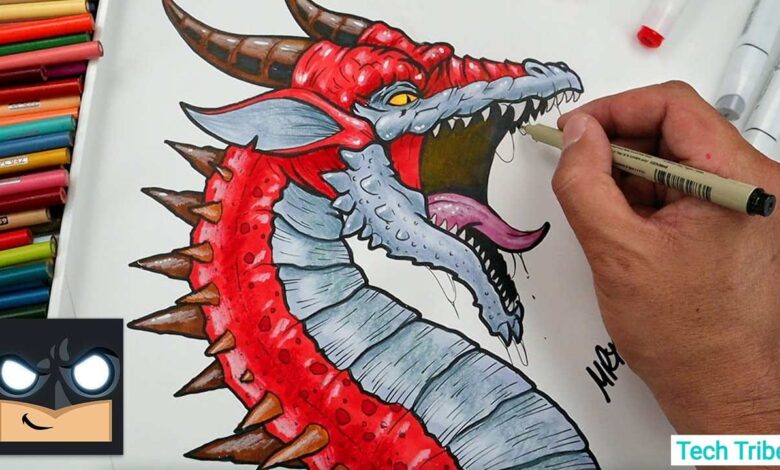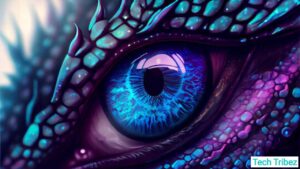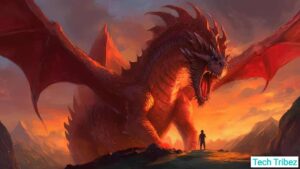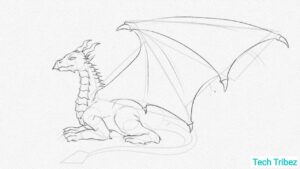Master the Art of Dragon Drawing: Techniques, Styles, and Inspiration

Drawing a dragon is a free-flowing art since it combines the imagination of the以后 creature with the mythical. Whether you are still learning to draw dragons or already more experienced, you should know some tips and tricks that will help you improve your artwork. Here, you will learn the basic principles of drawing a dragon, such as the role of contrast, the use of traditional drawing techniques, the technique of using various elements, how to frame, etc. The skills learned in each section of the article will help you improve your dragon drawing skills for better artwork.
Why is Mastering Contrast Essential in Dragon Drawing?
Scribble is high contrast, the critical underlying dynamic of art in dragon drawing; contrast is among the most vital components to complete your project. The contrast is excellent. If applied properly, it will make your dragon leap right off the page. One of the ways of achieving this is through the use of antithesis colour; for instance, the illustration of a dragon using blue and white.
This method reminded me of ancient China; dragons in blue on white backgrounds are often depicted on porcelain items. Not only does the contrast emphasize the dragon’s shape, but it also has a cultural aesthetic bonus in what you do. Also, combining different types of scales on the dragon against other specific body elements like skin, teeth, mane, hair, etc., will create a brilliant impact if applied in the dragon drawing. Thus, mastering contrast will enable you to create an eye-catching work that will draw the viewer’s attention to the details of your dragon.
What Makes the Blue Eyes White Dragon Drawing Technique Stand Out?
Everyone looks for ways to draw Blue Eyes White Dragon and the style that depicts the image powerfully and magically. This approach includes the liberal usage of blue tints, mainly focusing on the dragons’ eyes that contrast against a white backdrop. When picking colours, the onlooker should ensure a clear difference between the colours used.

Say, blue tries best with white to give the dragon a feeling of being alive. This technique is beneficial in depicting the otherworldly disposition of the dragon and the sense that one gets of the dragon coming out of the paper. Liner brushes are very helpful in getting sharper outlines of the dragon’s scales, eyes, and teeth so that each detail of the image is perfect.
In addition to the dragon’s body, the white negative surrounding the dragon also eerily strengthens the creature’s contour and makes the details stand out. Not only does this method bring out the tenacity of the dragon, but it also brings some sophistication to the artwork. As for the Blue Eyes White Dragon drawing technique, it is as robust and vibrant as it reflects the essence of the show while staying memorable in detail.
When Should You Use Traditional Dragon Drawing Styles?
The more conventional dragon drawing styles are historically and culturally based, perfect for maintaining the traditional perception of dragon artwork. These styles usually have broad lines, several details, and high symmetry, typical for many traditional tattoos and illustrations of antiquity. When drawing a dragon in the traditional style, one has to concentrate on describing the dragons represented in history. This might entail doing comparative analysis of dragons in cross cultural systems including the Chinese serpentine dragon and the European fire breathing dragons.
Classic themes are perfect for any design if the goal is to make furniture that would capture the identity of dragons as a cultural symbol. They are also suitable for flash sheet designs which involve creation of eye-catching and easily recognizable images. If you include these features in your drawing of the dragon, they will be great and will also be a way in which you will be able to honour these great mythical creatures.
Why Experiment with Natural Elements in Your Dragon Drawing?
Housing parts of the natural world into your dragon sketch may certainly lend a different night and day to your art form. Every dragon is portrayed as a legendary beast that represents natural elements, thus, the use of such elements as foliage, water or fire in its design adds to the naturalism factor. For instance, a leaf dragon drawing could be focused on the dragon-like figure, but made from the materials and with the patterns of patterns of the real leaves from a forest. This not only helps to play with different textures and the shapes of the dragons but also to think with the dragons in the creative way how they can approach to interact with the environment.
Including more natural aspects can also boost the uniqueness to your dragon drawing since it will look different from any other conventional drawings. Regardless of what is necessary for the creation of your dragon, these representatives of nature can complement your character in unconventional ways with the smoothness of a snake skin, roughness of the tree trunks and fluidity of water. Thus, when working on the dragon tattoo design, you can try to extend the ideas connected with it and come up with an interesting and outstanding piece inspired by nature.
What Are the Benefits of Adding Framing to Your Dragon Drawing?
Framing is another technique that many people forget in the process of drawing a dragon and yet it can make a great impact on your artwork. A frame can also be added on a drawing to enhance the depth and focus so that anyone who looks at the drawing will be able to know what to look at. For example, unusual positioning, such as when the contours of a depicted object for some reason enter the frame or a paw or horn is placed beyond the frame, will be interesting.
This helps in adding interest but at the same time provides the illusion of the dragon seeming to respond to its environment hence providing the feel of an alive element. Framing can also be employed to work on the differences between light and the dark part or the glossy and the rough part of the drawing. When developing your dragon drawing, you may wonder how to devise the edges and that will give a fresh appearance to your art workDue to the above facts, utilizing the frame is essential since it adds a professional look into your dragon drawing and makes it look neat.
Why Is Exploring Cartoon Dragon Drawing Important for Creativity?

Cartoon dragon drawing is an interesting and creative approach to reflect the posters’ desire for excitement based on cartoons and graphic imagery that exists in dragon depictions. Unlike traditional or realistic styles, cartoon drawing allows the draughtsman to be less liberal as to proportions, expressions, and colors.
This approach you find especially helpful to develop creativity as it urges you to explore many variations and forms of dragon. For instance, you might draw your dragon constantly grinning like an idiot, or having overly intelligent looking eyes or a tail that is twice the length of the whole dragon; this makes your dragon unique and people will remember it vividly.
Cartoon dragon drawing further enables you to add variation in design and it also brings more fun, and relatability in artwork. Through practising in this style, one is able to improve on their artistry in a fun and productive manner as well as improving on the various dragon drawing styles. If you have not followed proper drawing rules while drawing for a children’s book or if you wanted to just be playful with your art, cartoon dragon drawing is a good idea.
What Makes the Fox Dragon Drawing Technique Unique?
Fox dragon drawing technique is therefore a new form of depicting dragons that put together the profile of a fox with that of a dragon. This technique is used in a fox’s figure: the torso is stretched forward and such features as antlers, claws, and a snake-like tail are added. Fox dragon is a great example showing that a dragon can have almost any other animals’ characteristics integrated into its design.
They should try this technique if they like to play with the dragon as a concept and create products that are on the edge of the conventional illustrations of the dragons. Thus, if you decide to merge the fox with the dragon, you get a nice fairy-tale character that will not resemble other creatures.
The fox dragon drawing technique also gives a lot of space for creativity, as you can experiment with such elements as size, density, and shade of the hybrids. This approach is good for artists who would wish to bring out a piece of art that is unique and challenge themselves more with the dragon illustrations.
Why Incorporate Scary Elements in Your Dragon Drawing?
It is never wrong to incorporate some scary features to your dragon drawing as it adds another dimension, which makes people pay attention to it. This is because dragons are known to be powerful and ferocious creatures, therefore, by highlighting such qualities as power and ferocity a better image or picture is painted. I suppose that a dragon would be depicted with sharp teeth, horns, and a hanging tongue to illustrate that the depicted creature is enraged at the moment.
Such additives to the drawing such as having a raven devoured or having a landscape on fire will go a long way in increasing the perceived danger and energy within the applied artwork. You can also make your artwork scarier by rendering scary drawings of the dragon, which in return makes the viewer or anyone who is in front of the artwork more emotional. As the study of Gothic literature distinguishes, it is possible to evoke negative associations with the images of dragons and, thus create outstanding work.
It would also be beneficial for artists who love drawing dramatic scenes, since such technique lets you draw upon that element of fear and wonder which people have attributed to dragons for quite a long time. When deciding what to draw, scary things are interesting to add to your dragon drawing, so here is an example of drawing a fire breathing monster or a scary guardian.
What Are the Advantages of Using White Outlines in Dragon Sketches?
If you need some tips when you sketch your dragons, try using white outlines somewhere in your art pieces. While whites make the job to emphasize some of the features in the course of drawing, these features appear brighter in contrast to the dark areas of the sketch. It is important while drawing to look at position also this approach may bring depth and dimension so your dragon will appear more 3D.
For instance, if it’s a facet of dragon illustration you might use white outlines to demonstrate details like sharpness of its teeth, shape of its horns, or even texture of its scales. When drawing such a dragon contour, one can draw a black shadow below these white outlines in order to intensify the appearance of the depth and bring your dragon out of the page.
White outlines are especially useful when combined with strong dark colour because they contrast significantly, thus they focus the attention of the viewer to specific points. This technique is perfect for an artist who wishes to make his/her dragon sketch look quite unique and eye-popping to the beholder. For a professional-looking piece of artwork, white outlines for the dragon sketch will look the part.
When Is It Best to Use Step-by-Step Guides for Dragon Head Sketches?
As we have seen, checklists and tutorials are an artist’s best friend, especially if one is dealing with challenging subjects such as dragon heads. These guides are finer and give stepwise methods in which you are able to draw each component of the dragon head while not getting confused all along. A step by step tutorial is helpful for novices or people who have never engaged in dragon drawing before as the guide shows the correct way of drawing the dragon head from shapes to details.

This method gives the student an appreciation of the structure and dimension of a dragon head that would enable the student to come up with a balancing artwork. However, artists who may have been working for sometime may also find value in step by step tutorials because they provide new methods and approaches to the art that the artist may not have considered.
Still, for a dragon head sketch, it is useful to draw it following a guide so that a person may get an idea of the correctness of proportions but at the same time get enough liberty to create. Such guides are most effective when you are finding out the new style, struggling with a certain angle or dealing with the certain issue. They give you a good starting point from which you can determine how to draft and design an outstanding dragon.
Conclusion
The process of becoming adept at drawing dragon is a wonderful experience of creative and technical processes. Thus, there are many more techniques offering keys on how to improve the dragon artwork you are doing by focusing on contrasting, going back to the roots of art and trying out natural themes. You can also try framing, using cartoon styles and applying changes such as the scary features, the white outline, etc on your artwork to make them look even better.
Even for the most experienced professional, tutorials yield a great utility as a reference, as they make processes, which may seem intricate, accessible in sections. Following these methods and concepts, you will be able to draw dragons pretty looking as well as ones to the persona of the artist. Whether you want to doodle in a notebook, sketch on a piece of paper, or if your goal is to paint a picture of a dragon, the opportunities are endless.
FAQ’s
What is the importance of contrast in dragon drawing?
Contrast is very important in dragon drawing because it gives an aspect of depth and dimension, thus giving the art more appeal. Taking the ideas from the porcelain works, where there are big contrasts between bright blue and white, the illustrations will appear very expressive and attention will be focused on the dragon, his skills, and other details.
How can I create a Blue Eyes White Dragon drawing?
Based on the drawing, to create Blue Eyes White Dragon one has to paint the dragon’s eyes in bright blue colors and set the major background as white. Flash illuminates the otherworldly characteristics of the dragon while accentuating fine details. Liner brushes are quite suitable for such details, which makes it possible to make the dragon seem as real as it is.
When should I use traditional dragon drawing styles?
Use of traditional dragon drawing involves the old practices of painting or sketching dragons and this should be useful when you are working on a project that requires the traditional view of the dragon for instance in tattoo works or preference for historical looks of the dragon. These styles are normally characterized by thick and thin lines, thus making them suitable for flash sheet and timeless art.
How can I incorporate natural elements into my dragon drawing?
Using natural components such as leaves or water to your dragon drawing can make you come up with an artistic masterpiece. For instance, joining the body of a dragon with the feeling of surface of a leaf or simplification of the characteristic of water brings a completely different sensation to your artwork and helps to link the dragon with nature stronger.
What are the benefits of adding a frame to my dragon drawing?
Putting a frame or a border to your dragon drawing will only improve the whole picture because it gives depth and draws the attention of the viewer. This will create a dynamic touch as the dragon will come out of the frame and expand its presence to the entire surrounding space or environment where the art piece is to be hung; this will also add a professional outlook into your artwork.
Why should I try cartoon dragon drawing?
This fact means that while cartoon dragon sketching one can add some elements which are impossible in realistic drawing, for instance, ridiculous look on the face, or big ears. This style is creative in that it prompts you to really ‘out of the box’ and therefore your artwork will appear more familiar and appealing to the eye, to those children in the audience.
What makes the fox dragon drawing technique unique?
Fox dragon drawing technique is different from other drawing techniques because it involves the incorporation of a fox’s attributes and other typical dragon qualities. This is because this form of approach enables creative design of creatures that would have a familiar look yet different from the real natural world creatures while creating a masterpiece in the paintings.
How can I make my dragon drawing scarier?
To give your drawing a scarier look, focus on outlines of sharp teeth, presence of horns and an angry appearance on the dragon. Adding scenes such as a raven feasting on some prey or putting fire behind your character can create a feeling of the risk and thrill that often comes with the art better; therefore giving your art more appeal.
What are the advantages of using white outlines in dragon sketches?
By applying white lines on the basic dragon drawings we can identify some of its characteristics easily because they contrast with darker values. This technique brings the craft to another level as well as making our dragon look professional by applying bold colours as well as shadings.
When should I use step-by-step guides for dragon head sketches?
Learning checklists are most effective during the first flights, or when addressing difficult designs like the heads of dragons. These guides include step by step instructions of the whole process starting from depicting the main shapes to getting the idea of anatomy and proportion. As a result of them you will get an accurate and balanced dragon head sketch.



